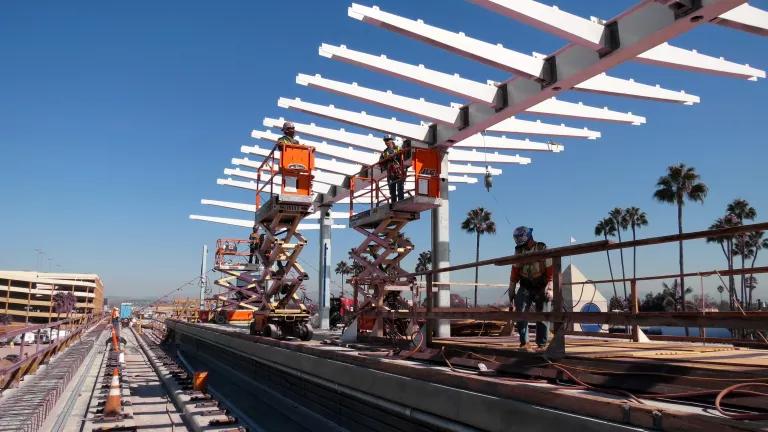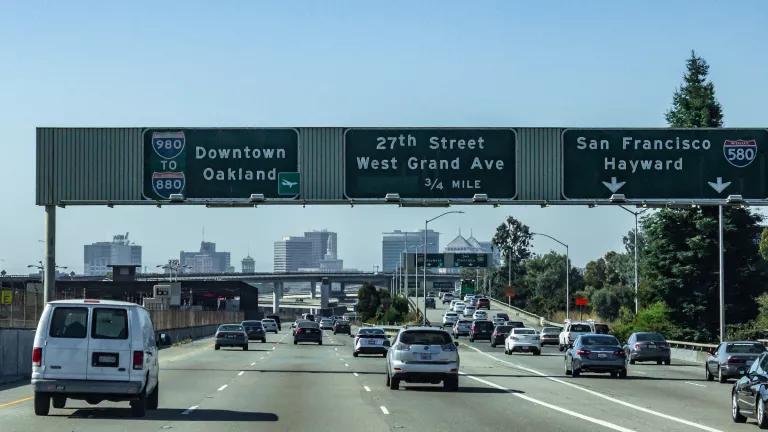New Transit Service Funding in California—and How States Can Find More
Advocates fought for funding to preserve transit service in California, winning a partial victory—and secured new guidance that could unlock billions more
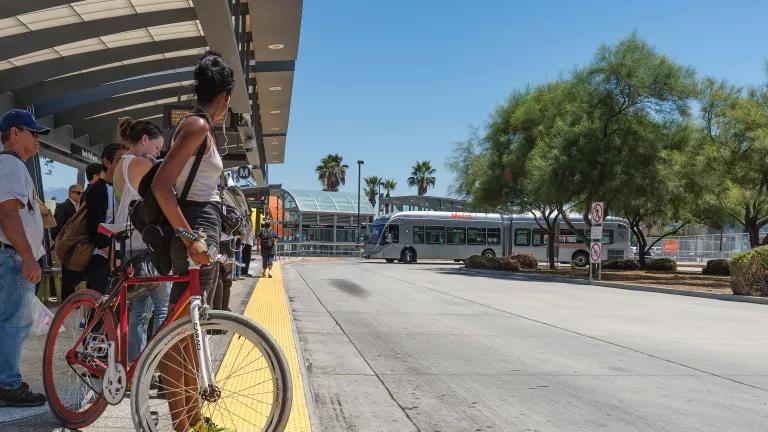
Orange Line riders wait to board in North Hollywood, Los Angeles, on the opening day for a new tunnel connecting the G Line (formerly Orange Line) to the B Line (formerly the Red Line)
Steve Hymon/Los Angeles Metro CC BY-NC-SA 2.0
California has responded in part to advocates’ calls to support public transit, though State leaders stopped short of using historic federal funding to help avert an imminent 'fiscal cliff.' Despite budget headwinds and a projected statewide deficit, California’s elected leaders recently allocated $1.1 billion in much-needed funding over four years to help transit agencies manage the transition to zero-emissions vehicle fleets and to help delay a funding shortfall caused by slower-than-hoped-for ridership recovery. State leaders also preserved $4 billion over two years in previous commitments to invest in transit infrastructure, and made all $5.1 billion of these dollars eligible for transit operations—not just capital expenses.
Most states and the federal government have focused on investing only in new physical public transit infrastructure like light rail tracks and stations (using “capital” spending), even though transit riders typically most desire more frequent service (funded by “operations” spending). The State has taken an important step by recognizing the importance of investing in transit service, in addition to new transit-supportive infrastructure. States and the federal government must continue finding ways to increase financial support for transit operations, in part because preserving and growing public transit service is mission-critical to eliminating pollution from the transportation sector, which remains the highest greenhouse gas–emitting sector both nationally and in the nation’s most populous state.
Under the umbrella of the Survive & Thrive Coalition, NRDC and fellow California advocates campaigned on spending eligible federal highway dollars to pay for transit to address the remaining funding shortfall. Even though California’s leaders didn’t pursue this option this year, the Survive & Thrive Coalition’s advocacy did secure a formal clarification from the Federal Highway Administration that states may move up to half of the funding they receive from the National Highway Performance Program into a transit ‘preventative maintenance’ funding account. This simple administrative change could unlock more than $45 billion in transit investment nationally in the remaining three years of the bipartisan infrastructure law’s implementation, if fully adopted. We hope that sharing this guidance will help other state leaders and environmental and transportation advocates across the country boost investment in public transit.
More work remains to be done to prevent transit service cuts in California in the short- and longer-term. The $1.1 billion in new funding falls well short of the $5 billion that transit advocates sought. Because the legislative budget agreement does not meet the estimated operating need, Senator Scott Wiener introduced legislation (SB 532) to provide further short-term funding to address the particularly acute funding gap in the Bay Area—before ultimately withdrawing the bill to continue regional policy discussions. Many local advocates’ attention will also now shift to shaping how these new state funds are allocated by regional transportation planning agencies, fighting for more transit investment in next year’s budget, and identifying what additional local funds may be secured to strengthen public transit networks throughout the state.
A $3 billion swing in transit funding from January to July—with more needed
With this $5.1 billion state investment in public transit (including $1.1 billion in new dollars, largely in funding from California’s cap and trade program, and the $4 billion that California leaders preserved in prior commitments) advocates increased transit funding in the budget by more than $3 billion relative to Governor Newsom’s January budget proposal, which only called for $2 billion in such funding. California joins Minnesota, New York, and Washington as states that have significantly increased financial support for transit in the past two years.
Still, only $1.1 billion of these dollars are ‘new’ commitments, relative to an estimated $5 billion statewide funding shortfall in the next five years. California’s financial commitment to public transit also lags states with the most robust transit systems, especially when it comes to operating expenses. For example, San Francisco’s MUNI and Bay Area Rapid Transit (BART) receive 9 percent and 4 percent of their operating budgets from the state, respectively, compared to peer agencies in the Northeast who receive between 20-50 percent of their operating funds from their respective state governments.
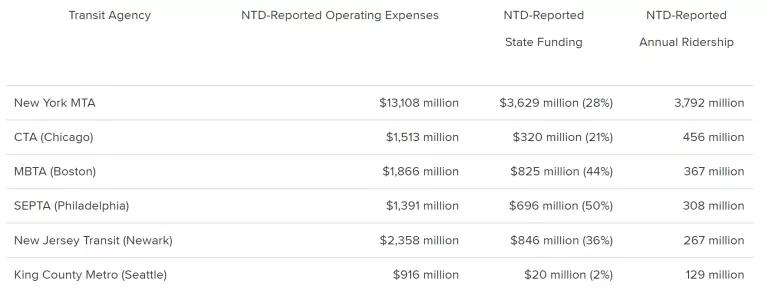
Use of State Funds to Support Operations of Select Large Transit Agencies Outside California, 2019 (SPUR)
There’s no way around it—the State’s climate progress depends on increasing financial support for transit. Thankfully, those transit investments will create more jobs, clean the air, and create more affordable and reliable transportation options for all Californians, especially the millions who either cannot drive or do not have reliable access to their own personal vehicle.
Biden administration provides clarity on using ‘highway’ funds to support transit
The bipartisan infrastructure law’s more-than-$600 billion allocation to transportation investments presents both risks and opportunities to climate progress. Funding that could go to new and bigger highways and generate more driving could instead be “flexed” or reallocated to support transit, biking, walking, and even electric vehicle charging infrastructure. Advocates in California are pushing for the Governor and Legislature to do that to the maximum extent possible. If fully leveraged, this could unlock more than $45 billion nationally in additional funding for bike, walk, and transit projects over the remaining lifetime of the infrastructure law—but doing so would require every state to take individual action. Over the past few decades Congress has steadily increased states’ flexibility to use formula dollars to support transit, biking, and walking projects, even adding zero-emissions vehicle charging infrastructure as an eligible expense through the bipartisan infrastructure law.
In California, many legislators and relevant staffers were unfamiliar with the option to reallocate flexible highway funding to public transit and had questions about how to implement it in the budget process. With this in mind, Senator Wiener and his staff worked with state and Bay Area transportation staff to connect key California decision-makers with federal agency staff who could provide clarity. When the Federal Transit and Federal Highway Administrations issued conflicting guidance, staff from the Metropolitan Transportation Commission assisted Senator Wiener’s office to successfully resolve the conflict and secure the final word from FHWA, which confirmed that it was appropriate and legal to “flex” or reallocate funds from the National Highway Performance Program into a transit ‘preventative maintenance’ account.*
While status quo politics prevailed in California this year and this transfer was not ultimately made, the legislature education and clear guidance will pay dividends in California and beyond in the coming years. This process surfaced an important, albeit technical, mechanism that allows states to leverage ‘highway’ funding to alleviate transit operations funding shortfalls.
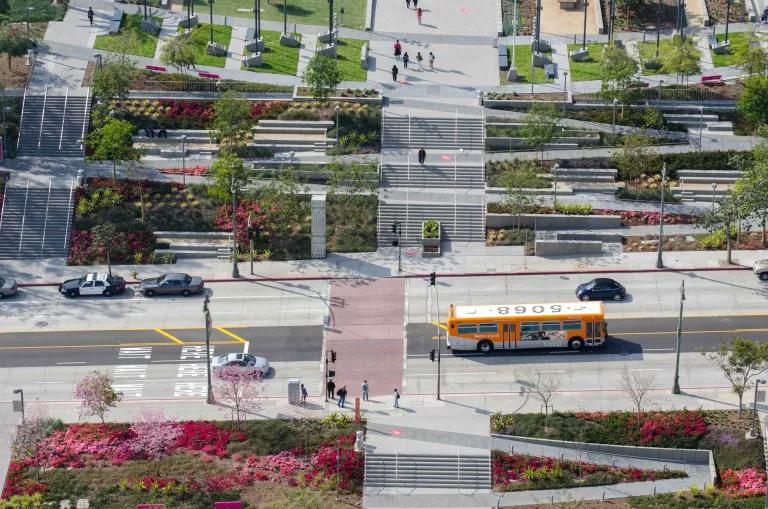
An aerial view of a bus passing by Grand Park in Los Angeles, California
Steve Hymon/Los Angeles Metro, CC BY-NC-SA 4.0
More work underway to close the remaining funding gap
California leaders’ commitment to transit will continue to be tested in the coming months and years, at all levels of government. In the ongoing State legislative session, SB 532 was considered before ultimately being withdrawn. SB 532 would have temporarily raised tolls on state-owned bridges in the Bay Area (except the Golden Gate Bridge, which has its own separate tolling authority) to generate nearly $1 billion in transit funding over as many as five years. This would have helped address the transit operations funding gap, preventing major service cuts that would disproportionately impact low-income, transit-dependent riders and increase vehicle miles traveled—at least until a long-term regional or other revenue source can be identified and secured.
The Bay Area is not alone in carefully considering its transit funding future—civic leaders in counties and regions throughout the state are working on local transportation funding ballot measures that will allow voters to decide whether to fund local transportation investment priorities. These ballot measures will cumulatively inform hundreds of billions of dollars in public investment—so it is imperative that local leaders prioritize increased transit frequency and funding for transit operations in the spending plans they bring to voters.
We have more work to do in next year’s budget to advance the priorities that NRDC laid out in February. We also need to ramp up our accountability advocacy, to ensure the State follows through on implementing its own existing policies. Thankfully, we have strong recent successes to build on.
* Or, as an FHWA Associate Administrator wrote in a June 2023 email, for those with an interest in the nitty-gritty details:
In general, preventative maintenance eligibility is limited under title 23 to Federal-aid highways per 23 U.S.C. 116(e). Earlier we were asked if preventative maintenance for transit was eligible under title 23. Preventative maintenance for transit is not eligible under 23 U.S.C. 116(e). We were not aware of that FTA had a specific defined term for “capital project” at 49 U.S.C. 5302(4) for transit programs that includes preventative maintenance. This term is not defined under title 23. STBG provides eligibility for “transit capital projects eligible for assistance under chapter 53 of title 23 U.S.C. 133(b)(1)(C)/23 USC 142(a)(2)). Because the statutory definition of “capital project” at 49 U.S.C. 5302(4) includes preventative maintenance, FHWA can interpret preventative maintenance for transit as eligible for STBG funds, which is consistent with FTA’s longstanding interpretation.
Under 23 U.S.C. 126, States may transfer up to 50% of their apportionments to other programs. Once such funds are transferred to another program, the transferred funds assume the requirements of the program to which they are transferred. For example, a State may transfer a percentage (not to exceed 50%) of its NHPP apportionment to its STBG apportionment to add to the amount of available STBG funds. Once transferred, those funds may be obligated for any eligible STBG purpose.


